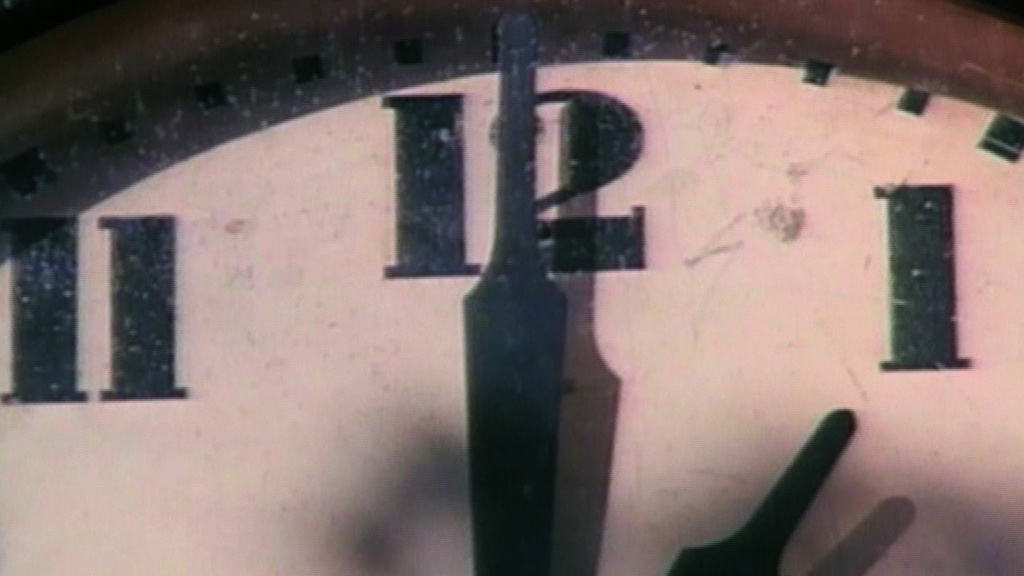It is precisely 3:46 pm when I arrive at the Power Plant, the Harbourfront Centre’s contemporary art hub. I am 16 minutes late for the media preview of Christian Marclay’s “The Clock.”
As a journalist, tardiness is not in my nature. In fact, I am fanatically obsessed with punctuality. I often feel acutely aware of the passage of time in the daily rush to meet remorseless deadlines.
“These days, everybody is obsessed with time,” says Gaetane Verna, the director of the Power Plant, in an interview with me the day before the screening. “ [They’re] always checking their BlackBerries.”
Guilty as charged.
“The Clock” is comprised of more than 10,000 clips, all depicting time and its passage, plucked from countless films and spliced together into an endless loop that is coordinated down to the second with “real world” time. Thus, when I finally enter the theatre at 4:09 pm, I am greeted by Mia Farrow lying in bed in a scene from Rosemary’s Baby, while a fictional clock next to her reads the same time as my watch.
I tell the receptionist that I plan to stay for around two hours, which is optimistic, considering I sometimes have a hard time sitting through the entirety of a normal movie, let alone an art film. As I am ushered into the small theatre that will play host to “The Clock” for its Toronto debut, I would not have predicted that more than four hours of my life would fly by as I sat, hyper-attuned to each passing minute of Marclay’s 24-hour spectacle. Midway through the showing, it occurs to me that Marclay has constructed the ultimate monument of the digital age, using cinema as his building blocks.
***
Christian Marclay, the creator of “The Clock”, is 57 years old. He has suggested that his modus operandi as an artist is to take “images and sounds that we’re all familiar with and reorganize them in a way that is unfamiliar.”
Ironically, “The Clock” has already become as ubiquitous in the contemporary art world as Damien Hirst’s shark in a tank or jewel-encrusted skull. Neither of Hirst’s works strikes me as nearly as accomplished as Marclay’s. To younger generations, “The Clock” may well be the most approachable artwork that has come along in some time. Marclay has positioned himself as the epitome of the artist in the age of the YouTube mashup, and his previous work in video affirms as much.
In his 1995 “Telephones,” Marclay borrows movie scenes of people talking on the phone, stitching them together to create a hilariously stilted conversation (“Darling, it’s me.” — “What?”— “The girl is dead.” — “Do you have a positive ID?” — “I’m so confused!”). Apple famously attempted to option the work for the first iPhone advertisement. When Marclay declined, Apple executives put together a cheap knock-off and aired it anyways.
In 2007, Marclay released “Crossfire,” again borrowing scenes from movies, this time of close-ups of gun shots. In the dark, the film was simultaneously projected onto the four walls of the gallery where it was screened, and the deafening bangs looped together to create a rhythmic, frightful, and profoundly visceral experience.
Gaetane Verna, the gallery director, warns me not to think of “The Clock” as a film because it lacks a plot, a beginning, middle, and end, and a cast of characters. Yet in many senses, like its source material, “The Clock” retains its own internal logic and rhythm, its own motifs and recurring themes. Thousands of clips miraculously cohere, and the project fits together like clockwork.
In the build-up to each new hour, the chosen clips grow progressively more frantic. Actors playing Wall Street traders shout that they need more time, gesticulating wildly and screaming into the phone; Lola streaks down the mean streets of Berlin; Leonardo DiCaprio runs to catch the Titanic. Big Ben appears so often it practically becomes a character unto itself, and fittingly, at midnight, just after Orson Welles flings himself off a clock tower in The Stranger, Big Ben violently explodes in the climactic shot of V for Vendetta.
The hours are also constructed of suitably timely material: around 5:00 pm, factory workers punch out and desk-bound 9–5ers joyfully exit their cubicles. By 5:30 pm, a montage of wives from various time periods slide roasts in the oven and prepare dozens of dinners. By shortly after 7:00 pm, evening meals have given way to spurned spouses bemoaning absent husbands. As Julianne Moore says to her servant in Far From Heaven: “It’s nearly twenty after, and Mr. Whitaker still hasn’t phoned!”
As I exit the theatre, Katharine Hepburn is setting the table, complaining about the absence of her husband, played by Spencer Tracy: “Isn’t that typical! Twenty minutes of eight.”
I glance at my watch: 8:20 pm.
***
If you visit just one gallery this season, make it The Power Plant. Thanks to a sizable donation from the Hal Jackman Foundation (the charity endowed by the former chancellor of U of T, whose generous donations also allowed the university to establish the Jackman Centre for the Humanities), admission is free for the entire year.
Be prepared to wait in line though. Unlike a normal theatre, “The Clock” is screened in a small room with nine comfortable, white IKEA couches spaced throughout. The couches make it enjoyable to sit and watch for hours, but this also means that turnover time can be agonizingly slow. Eat beforehand., as food is not permitted in the theatre and dining scenes around the lunch and dinner hour can induce a powerful appetite. Visit at a random hour (one colleague of mine announced her plans to visit at 3AM, having seen much of the day during screenings earlier this year at the National Gallery in Ottawa), or drop by when you are in the neighbourhood. Stay as long as you can, and watch the time go by.


